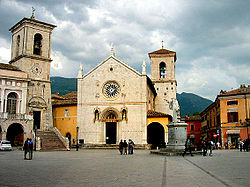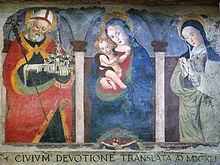- Monks of Norcia
-
 The Seal of the Monastery
The Seal of the Monastery
The Benedictine Monks of Norcia (Italian: Monastero di San Benedetto di Norcia) are located in Norcia (formerly Nursia), Italy, in the extreme southeast tip of Umbria beneath the slopes of the Sibylline Mountains. The current monastery is physically located above the 5th century ruins of the the house of St. Benedict and his twin sister St. Scholastica, and has been the location of monastic communities since the tenth century AD. Today the Monks of Norcia care for the spiritual, pastoral, and temporal needs of approximately 50,000 pilgrims from around the world who annually visit the birthplace of Sts. Benedict and Scholastica.
Contents
History
In the 8th century an oratory was built so pilgrims could pray at the place of St. Benedict’s birth. Monks came to Norcia in the 10th century, and remained in one form or another until 1810, when they were forced to flee under the new laws of the Napoleonic Code. The current Benedictine community was founded in Rome on September 3, 1998, without being conditioned by previous historical circumstances. These original monks transferred from Rome to Norcia on December 2, 2000, in the great Jubilee Year, becoming The Benedictine Monks of Norcia. They were charged by Rome to care for the Basilica of San Benedetto (built over the birthplace of St Benedict and St Scholastica) and for the many visiting pilgrims. The Benedictines of Norcia see themselves as humble instruments for the necessary New Evangelization of Europe.[1] As of July 2011 there are nineteen monks living at Norcia, four of which are ordained priests and two novices.[2]
Charism
The charism of the Monks of Norcia is “to return to the spirit of the founder,”[3] following the explicit appeal of the Vatican II document on Religious Life, Perfectae Caritatis. On April 21, 2009 the Holy See entrusted to the community the special liturgical apostolate of celebrating both forms of the Roman Rite (in utroque usu - “according to both usages”): the Extraordinary and the Ordinary form.[4] This makes the Benedictine Monks of Norcia one of the few religious communities throughout the world that celebrates both forms of the Roman Rite (See "Traditionalist Communities in good standing with the Holy See" under Traditionalist Catholic).
The Seal
The Seal of the Monastery is divided into two sections. On the left hand side is the symbol of the Celestine monks who were present in Norcia before being suppressed by the Napoleonic laws of 1810, representing the continuity with the past. The Celestines were part of a wide-spread movement in the Church in the thirteenth century which emphasized the power of the Holy Spirit. Their symbol, therefore, is a large S, standing for Spiritus Sanctus.
The right side of the seal represents the present: a stump with new shoots of life growing from it. The stump represents monastic life violently cut off in 1810. The new shoots of life represent the present community, and the three leaves represents the three original monks who arrived in Norcia in 2000. As the prophet Isaiah says: “There shall come forth a shoot from the stump of Jesse, and a branch shall grow out of his roots” (Is 11:1). This image has always been a sign of hope.
References
- ^ Die Tagespost [1], Werkzeug der Neuevangelisierung, July 20th, 2011.
- ^ Ibid.
- ^ Perfectae Caritatis [2], Decree on the Adaptation and Renewal of Religious Life, proclaimed by His Holiness Pope Paul VI on October 28, 1965.
- ^ In this way the monastery takes to heart the words of Benedict XVI that there should be a mutual enrichment of the Ordinary and Extraordinary Forms of the Roman Rite: "The two Forms of the usage of the Roman Rite can be mutually enriching... What earlier generations held as sacred, remains sacred and great for us too, and it cannot be all of a sudden entirely forbidden or even considered harmful. It behooves all of us to preserve the riches which have developed in the Church's faith and prayer, and to give them their proper place." (Pope Benedict XVI, Letter to Bishops, 7 July 2007 [3]).
External References
Wikimedia Foundation. 2010.


